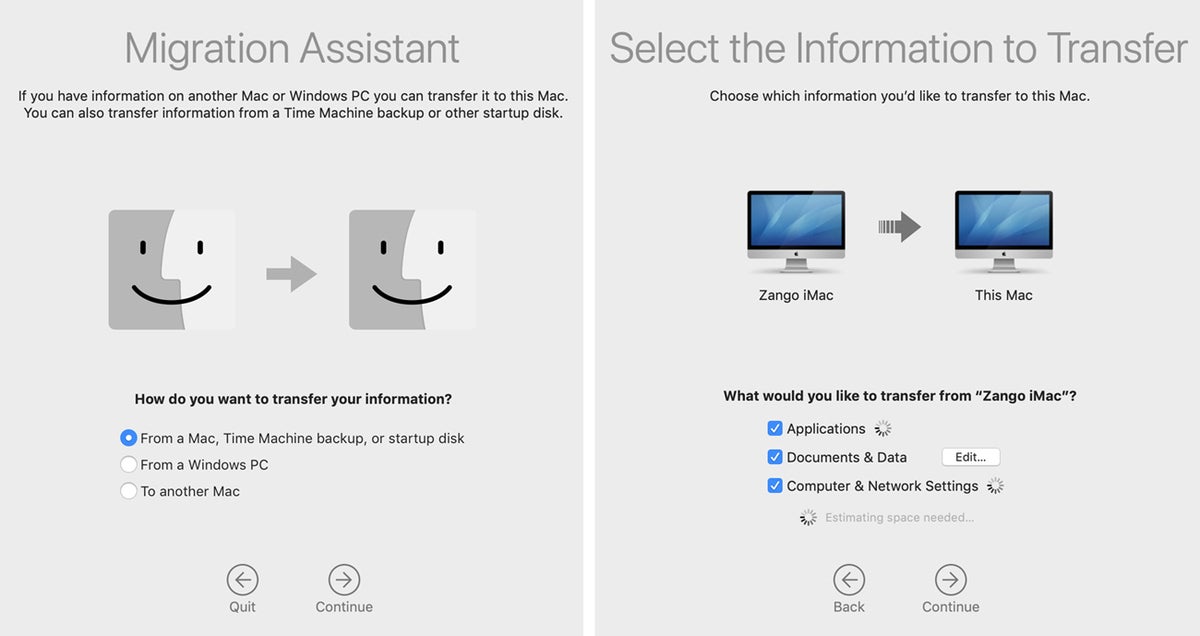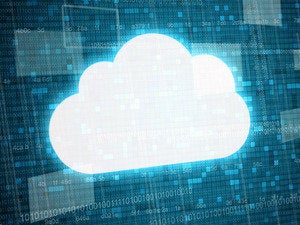Old Mac, new Mac. It’s great to get a new computer, but it’s not so great to realize that all your stuff is on the old one.
There are several ways to transfer your old computer’s files, apps, and settings to your new Mac. The best and easiest way is to use a cloud storage service as the waystation. Cloud storage works whether you are moving from one Mac to another or from a Windows PC to a Mac. Our article “The best way to transfer files to a new Windows PC or Mac” explains the ins and outs of migrating to a new computer via the cloud.
However, you may not be able to use the cloud to transfer your files — for instance, if the data-usage costs would be too high or you are not connected to the internet, or if your IT department won’t let you install the cloud account on both the old computer and the new Mac.
And you might want to transfer more than just files from your old computer to your new one. This story includes methods for migrating files and apps; two methods can transfer system settings as well.
Transferring files locally to a new Mac
There are several methods to transfer files locally from an old computer to a new Mac, and most work whether you’re moving from a Mac to a Mac or from a Windows PC to a Mac.
Direct file transfer via an external drive or file sharing
You can connect an external hard drive, SD card, or thumb drive to your old computer, copy your files to it, then eject that device from the old computer, plug it into the new Mac, and copy the files to that new Mac. The trick here (besides having enough storage capacity on your transfer drive) is to have your files and folders organized well enough so you get them all.
Tip: If you are transferring files from a PC to a Mac, the external hard drive must be formatted as MS-DOS or NTFS, not APFS. SD cards and thumb drives use the same FAT32 format on both macOS and Windows, so if your files fit on those storage devices, that’s often easier than using a hard drive.
If you’re particularly savvy, you can transfer files from one Mac to another on the same network using file sharing instead of an external drive. First, enable file sharing on the source Mac: click the Apple menu at the top left of the screen, choose System Preferences > Sharing and check the File Sharing box. Next, connect the new Mac to the source Mac over the network: with a Finder window active on the new Mac, go to the Finder menu at the top of your screen and choose Go > Network, then select the source Mac to mount it as a network drive so you can work with it. You can then open that network drive in Finder and copy folders and files from it as you would from any drive, although you may need to enter a username and password to access the shared Mac’s drives.
You can even transfer from Windows PCs this way, since macOS supports the Windows SMB file-sharing protocol, but the setup can be a bit tricky on the Windows end. Apple has provided basic information for Windows-to-Mac networked file sharing.
Whether you’re transferring files via an external drive or over a network, I recommend that you use the same folder organization on your new Mac as on your old computer, at least to start. Once your migration is complete, you should consider storing your files on the cloud for easier access, as the article “The best way to transfer files to a new Windows PC or Mac” explains.
Note: Digitally rights-managed files like purchased music usually won’t work once copied. The best way to transfer these is to re-download them from the service where you bought them. Such re-downloads are typically free.
Direct file transfer will not move your locally stored email files to the new Mac. MacOS stores these files in fairly arcane places, and copying them to a new Mac often doesn’t work because of how they are tied to the email application’s OS settings. I recommend you make sure all your emails are stored in your email server (that is in, in your email client make sure all your emails reside in folders stored on the server), so they can just sync to the email client on your new Mac. The Apple Mail and Microsoft Outlook clients support several servers, not just Microsoft’s Exchange and Microsoft 365/Office 365 typically used in business.
Note: IT retention policies may limit how far back emails are stored on the server, so you may have local emails you can’t transfer that way. In that case, Microsoft Outlook does let you import the local PST files to a Mac from the Outlook app on another Mac or Windows PC; Microsoft has provided the export instructions for Windows, and here are the separate Mac export and import instructions.
Local contacts and calendar entries likewise are very difficult to directly transfer from one computer to another, and it is best to make sure they are stored on a server, such as Exchange, Microsoft 365/Office 365, G Suite/Google Workspace/Gmail/Google Calendar, or iCloud, so they will sync to your contacts and calendar apps on your new Mac. Your contacts and calendar apps may have an export feature that you can try. (You can often export individual contacts as a VCF file, for example.) These days, few contacts and calendar apps are not server-based, so chances are very high your contacts and calendar entries are stored somewhere they can be synced from into Outlook or into Apple Contacts and Calendar.
Transfer via Migration Assistant
MacOS has long had the Migration Assistant file-transfer utility, which lets you transfer selected folders (and their files), applications, and settings from one Mac to another, as well as from a Windows PC to a Mac. It’s the best option for moving content from an old Mac to a new IT-managed one, since it won’t affect IT’s setup of macOS, administrator accounts, and corporate applications.
Migration Assistant can be run at any time; it resides in the Mac’s Utilities folder inside the Applications folder. When you first set up a new Mac, you also get the option to run Migration Assistant during that initial setup.
Migration Assistant needs something to transfer from; that something can be a Mac, a PC running Windows 7 or later, or a Time Machine backup drive. The source computer can be connected to the same network (via wired Ethernet or Wi-Fi) as the new Mac, or via a direct Ethernet connection between the old and new computers. A Time Machine backup drive must be directly connected to your new Mac or over the network if an Apple AirPort Time Capsule device is used for the backup.
If you want to transfer files from a Windows PC to a new Mac, you also need to install and run the Migration Assistant for Windows software on the PC; the required version of that software depends on which version of macOS you have. Note: Be sure to uninstall OneDrive on your Windows PC before migrating the PC to a Mac; you can reinstall OneDrive on that PC when done.
Once everything is properly connected or networked, run Migration Assistant and follow the prompts to select the source for the restore/clone and what to restore/clone. You can also initiate a Migration Assistant transfer to another Mac, which requires Migration Assistant to be running on that Mac. It’ll take a while to copy the selected folders and files, depending on how many there are.
 IDG
IDG
Migration Assistant lets you choose the source for your restore/clone (left) and the content from that source to restore/clone (right). (Click image to enlarge it.)
Note: If you intend to transfer applications from your old Mac, first sign out of or deactivate any apps on your old Mac. Most software these days is tied to an online account that limits the number of active installations or has digital rights management to prevent piracy via copying.
Note: You must have administrator access on your Mac to run Migration Assistant.
Transfer via a Time Machine backup
MacOS has also long had the built-in Time Machine backup utility that lets you restore an entire Mac — applications, files, settings, and so on. (It resides in the Applications folder.) You can use Time Machine to essentially restore a Mac onto another Mac — it clones the Mac, basically. (Time Machine doesn’t work for migrating a Windows PC to a Mac, of course.)
This is the most thorough way to duplicate an existing Mac into another, and it’s best to use it for migrating a personal Mac to a new personal Mac or an IT-managed Mac to an IT-managed Mac. Migrating a personal Mac to an IT-managed one, or vice versa, risks violating security policies, software licenses, and IT management standards. A personal-to-work Mac clone means IT’s management and other settings are not in place on the work Mac, and a work-to-personal Mac clone likely means IT has control over your personal Mac is ways you may not realize or want.
Tip: You can also restore specific files from a Time Machine backup drive onto a new Mac. Use the Migration Assistant utility, covered in the previous section, to do so.
Time Machine is the gold standard for computer backup. To set up backup, connect an external drive to your original Mac. Connecting the backup drive via USB or other wired port is the fastest method, but you can also use a wired or wireless network if your backup drive is connected to a Time-Machine-compatible router, as many recent routers are. Next, go to System Preferences > Time Machine, select the backup drive using the Select Backup Disk button, optionally turn on disk encryption for your backup drive, and check the Back Up Automatically option.
Note: Before you restore/clone a Mac to a new Mac, I strongly suggest you first sign out of or deactivate any apps on your old Mac. Most software these days is tied to an online account that limits the number of active installations or has digital rights management to prevent piracy via copying. Even though you are cloning an existing setup, it’s possible that the piracy prevention may detect that the software is running om a new Mac and thus assume it was copied illegally.
Restoring or cloning a Mac from Time Machine is a bit more complicated. You have to use macOS’s Recovery mode. First, shut down your new Mac, then connect your Time Machine backup drive to it. Next, turn your new Mac back on, pressing and holding ⌘-R immediately. Be a little patient until the macOS Utilities window opens. Click Restore from Time Machine Backup, then click Continue. In the next window, select the Time Machine backup drive to restore/clone from, then click Continue.
You may get a list of available backups, since Time Machine maintains a history that lets you choose an earlier backup if desired, such as to restore a Mac from before it became infected with a virus or got corrupted. Select the desired backup version (if there’s only one available, it is pre-selected) and click Continue. In the next window you will be asked what drive to restore the backup to. In this case you want the startup drive for your new Mac; select it and then click Restore.
Now wait patiently for the restore, which can take an hour or longer depending on how much was stored on your original Mac. Restart your Mac when the restore is complete.
Transferring and setting up apps on your new Mac
No matter what transfer method you use, you may have apps to reinstall, depending on what IT did for you in preparing your new computer. For example, software that uses digital rights management may need to be reinstalled even after it is migrated using Time Machine or Migration Assistant, because the digital rights management may recognize that the underlying computer has changed. It is best to deactivate any software that uses digital licensing before transferring it, then activate the software on the new machine after it is migrated or reinstalled.
On your new Mac, re-download the apps you need and sign in as required. You’ll find some apps on the Apple Mac App Store, while others you’ll need to download from the manufacturer’s website. If you’re moving from Windows to macOS, some apps won’t be available for installation in macOS, but many widely used Windows business apps come in both versions, and most software manufacturers (but not all!) let you use the same license on either platform.
In most cases, you’ll need to set up your applications’ preferences on the new computer, so set aside the time to do that.
Transferring browser bookmarks to your new Mac
You also will want to transfer your bookmarks from your old computer’s browser to your new computer’s browser. There are three methods: direct syncing between the same browser, syncing between macOS’s Safari and certain Windows browsers, and exporting a browser’s bookmark files to import into a different browser. The first two methods keep the browsers in sync, whereas the third method is a manual approach for when you are moving to a new computer (or browser) and won’t use the old computer (or browser) anymore.
Chrome, Firefox, and Edge all sync bookmarks across all your devices if they are all signed into the same account. Just enable syncing in each browser on each device you use. To be clear, you can sync only to the same browser, such as from Chrome to Chrome.
Apple’s Safari is not available for Windows (or Android), but you can sync between Safari and a supported Windows browser (Internet Explorer, Chrome, and Firefox) if iCloud is installed in Windows and signed in to the same account as the Mac or iOS device running Safari. Note: iCloud syncing is not available for education users with managed Apple IDs.
For situations where your browser is not signed into the same account as your old computer, the major browsers all have a facility to export and import bookmarks via files:
- Google Chrome: To export bookmarks, click the vertical three-dot icon at the top right of your browser window, then select Bookmarks > Bookmark Manager from the menu that appears. Click the three-dot icon to the right of the search bar and select Export bookmarks. To import bookmarks, follow the same procedure but choose Import bookmarks instead of Export Bookmarks.
- Mozilla Firefox: To export bookmarks, use the keyboard shortcut ⌘-Shift-B in macOS or Ctrl-Shift-B in Windows to open the Library window, which shows all your bookmarks. Select the desired bookmark folder (or All Bookmarks), then choose the Import and Backup button (in macOS, it’s the icon of two arrows) > Export Bookmarks to HTML. To import bookmarks, follow the same procedure but choose Import Bookmarks from HTML instead of Export Bookmarks to HTML.
- Apple Safari: To export bookmarks from this macOS browser, choose File > Export Bookmarks. To import bookmarks, choose File > Import From > Bookmarks HTML File.
- Microsoft Edge (legacy version): To export bookmarks from this Windows 10-only browser that is pre-installed in Windows 10 versions prior to 20H2, click the three-dot icon to open the General window, click Import or Export to open the Import export window, scroll down until you see Export your favorites and reading list to an HTML file, select Favorites to export your bookmarks, then click Export to file.
- Microsoft Edge (Chromium version): In both Windows and macOS, to export bookmarks from this optionally installed Chromium-based browser that will become the Windows 10 default starting with version 20H2, click the Favorites button (the star icon), then choose Manage favorites to open the Favorites window, select the desired bookmarks folder to export, click the horizontal three-dot icon at the top right of the browser window, and choose Export favorites. To import bookmarks, follow the same procedure but choose Import favorites instead of Export favorites.
- Internet Explorer: To export bookmarks from this discontinued Windows browser, click the Favorites button (star icon), choose Import and Export from its menu, select the Export to a file option, click Next >, select Favorites to export bookmarks (and optionally Feed and Cookies to export them), click Next >, choose the bookmarks folder to export, click Next >, set the export location, and click Export.
When everything is transferred, be sure to sign out of all your accounts, such as Microsoft, Google, iCloud, iTunes, browser sync, shopping, and cloud storage accounts, on the old computer. You don’t want to exceed any maximums on computers that can be signed in, and you don’t want the next owner to be able to use your accounts, especially any that may connect to credit and debit cards. You might even consider wiping/reformatting the old computer, but check with IT first, in case they need to keep it as is for some period of time for regulatory or HR policy reasons.
Further reading:
- How to switch from Android to iPhone
- How to switch from iPhone to Android
- How to move data between your Android phone and a computer
- How to move files between an iPhone and Android phone









